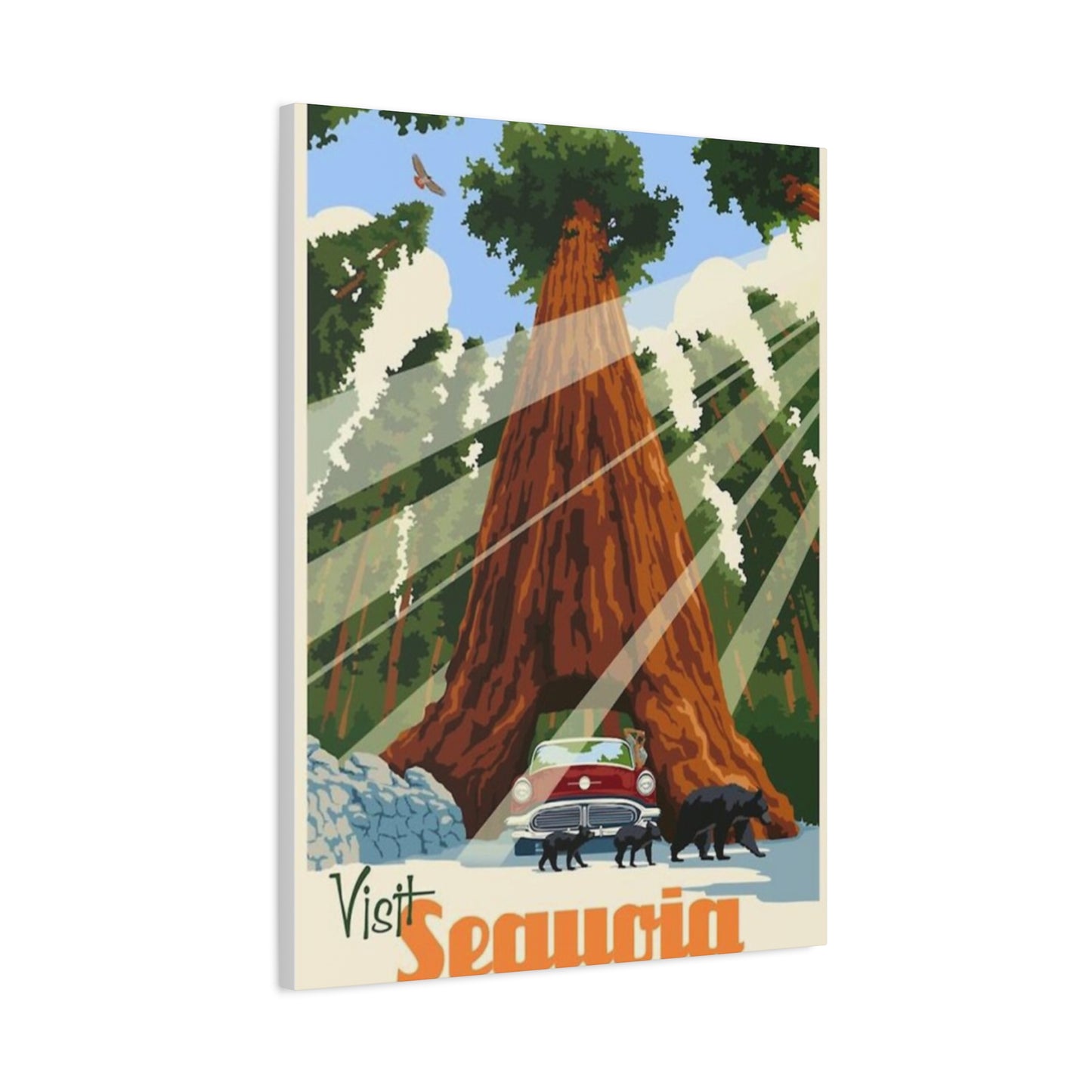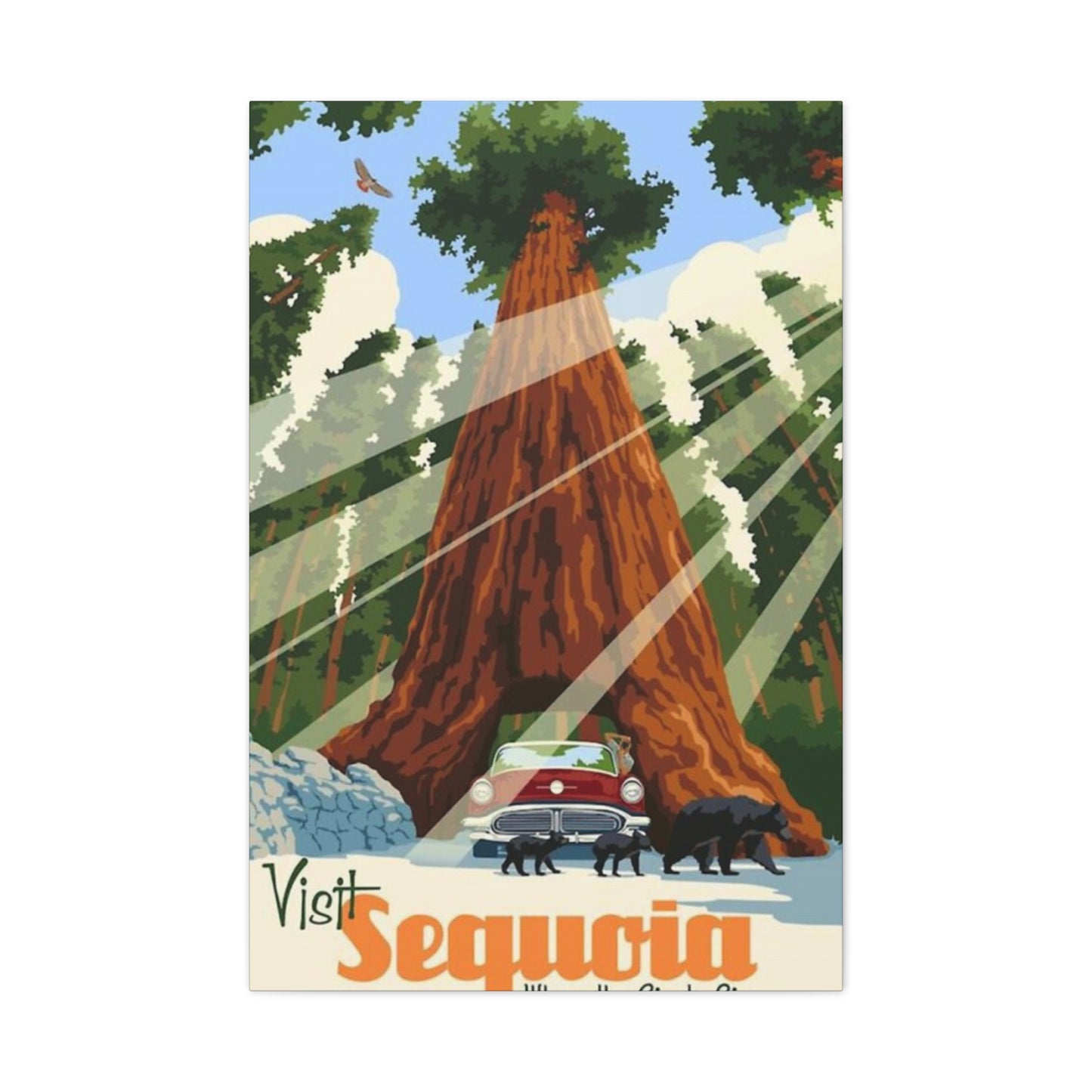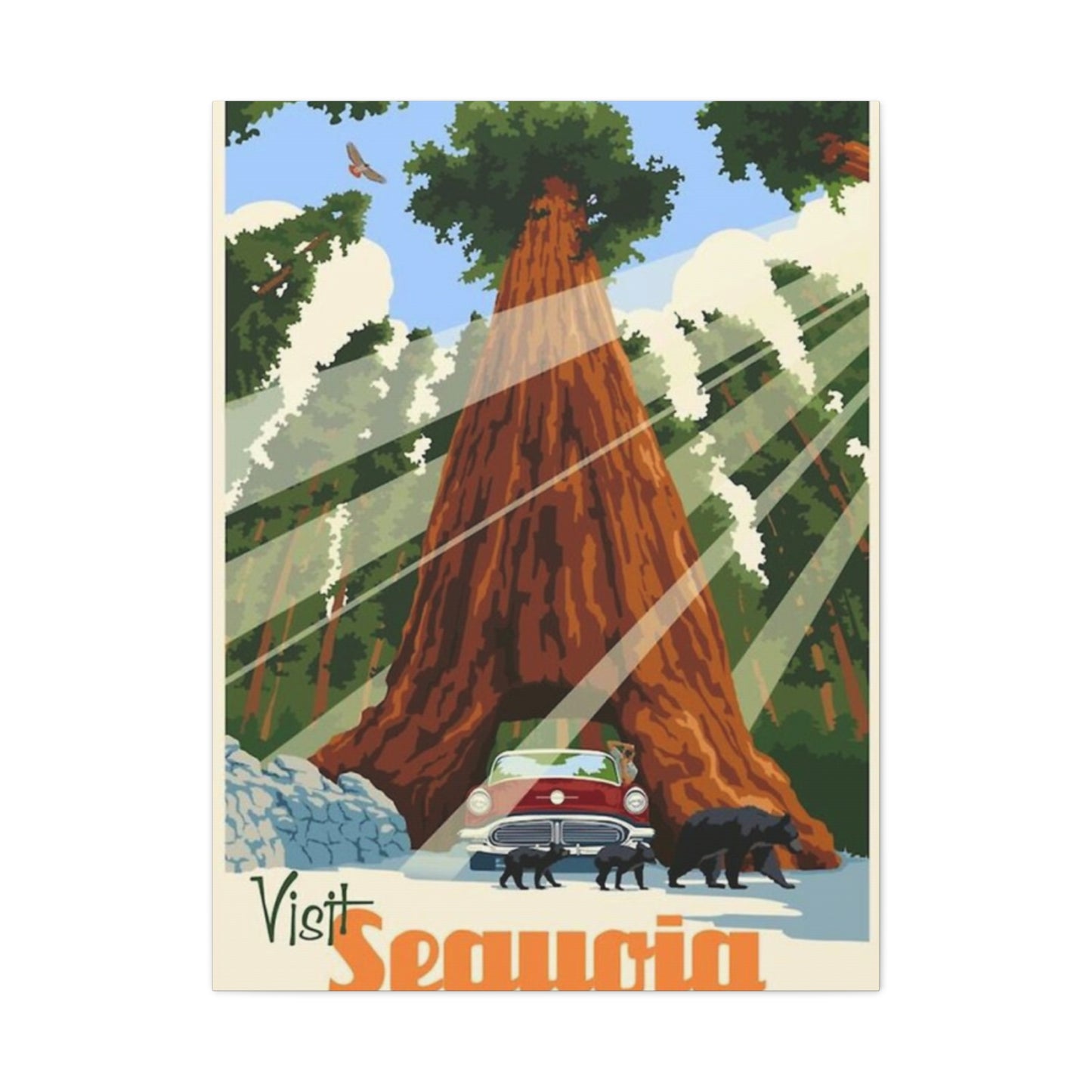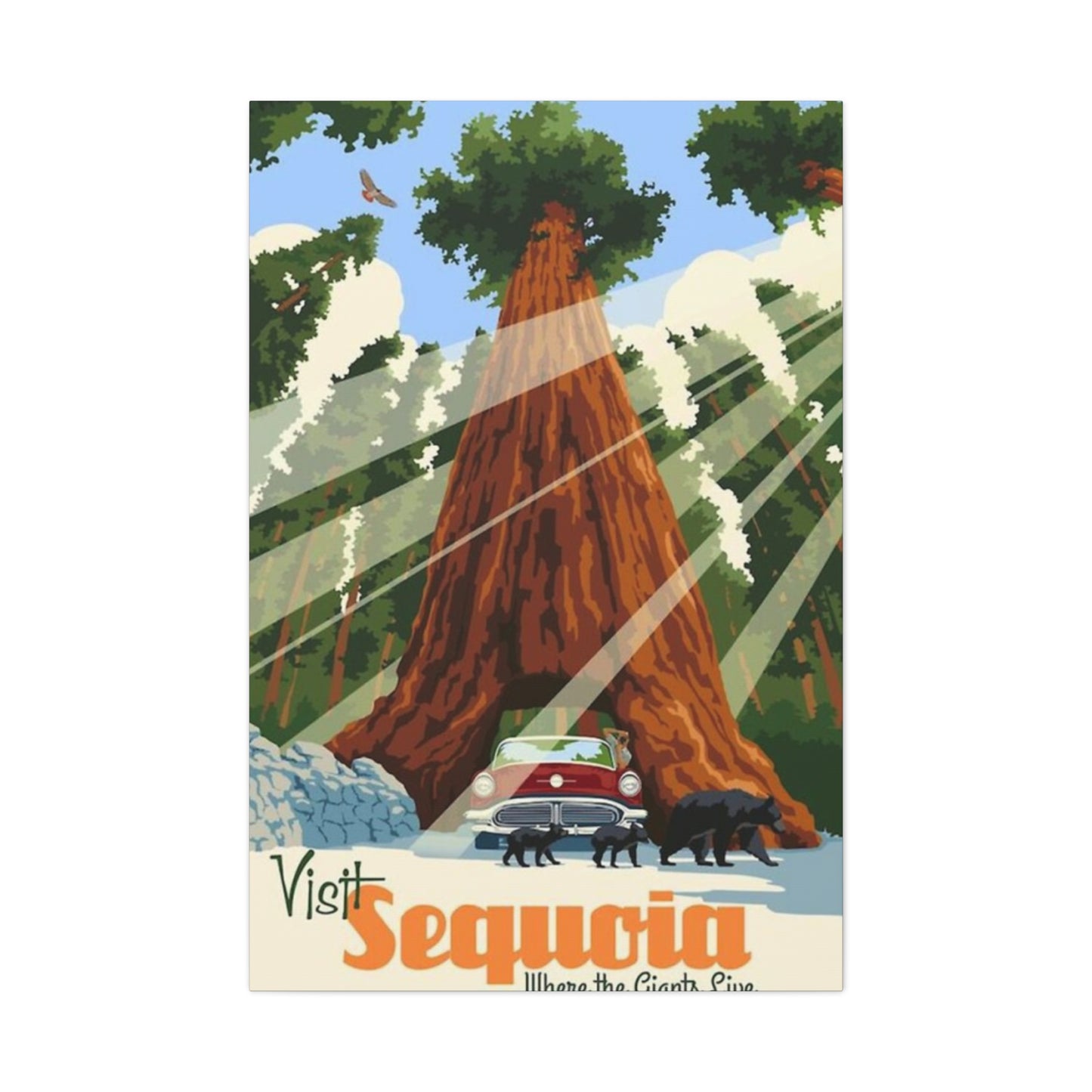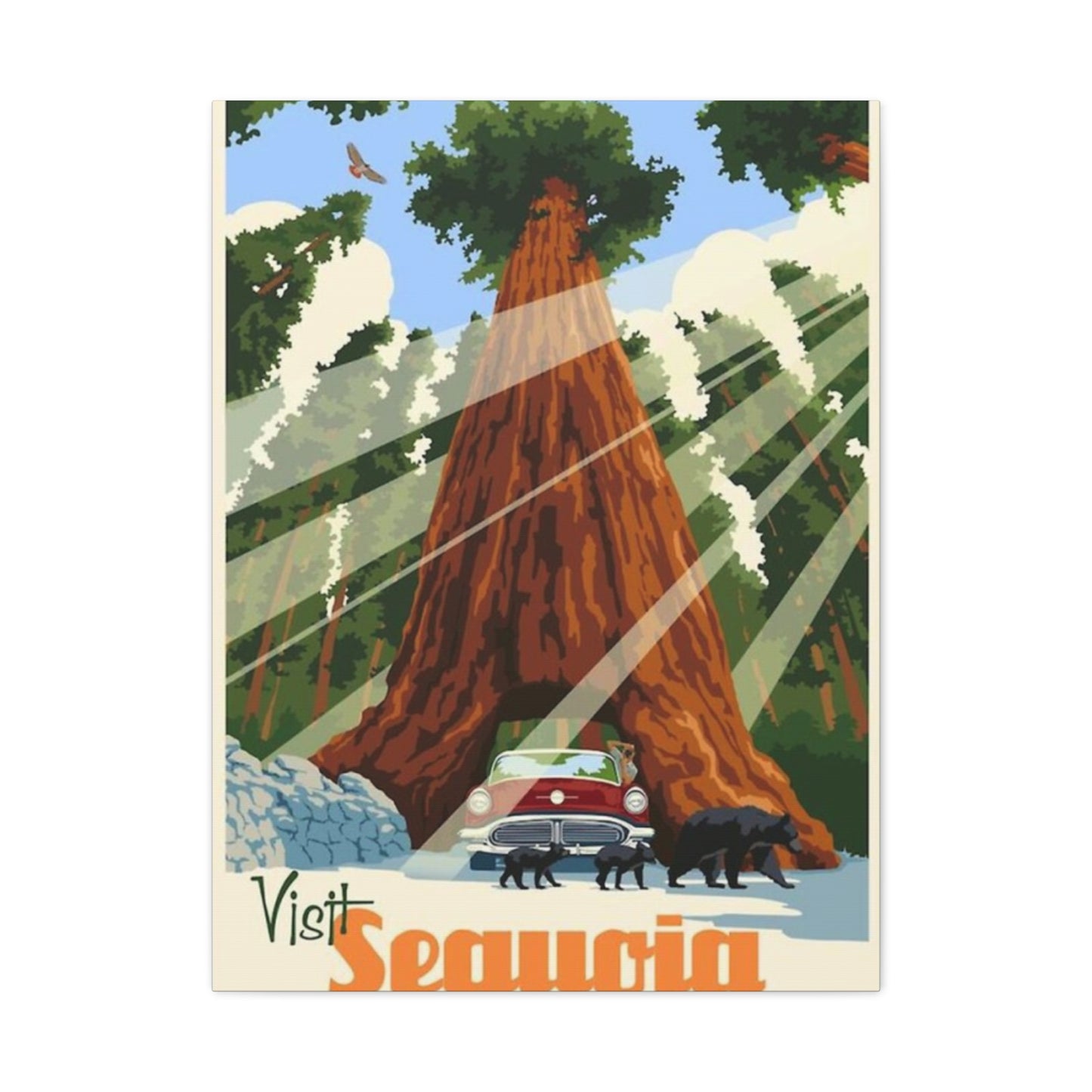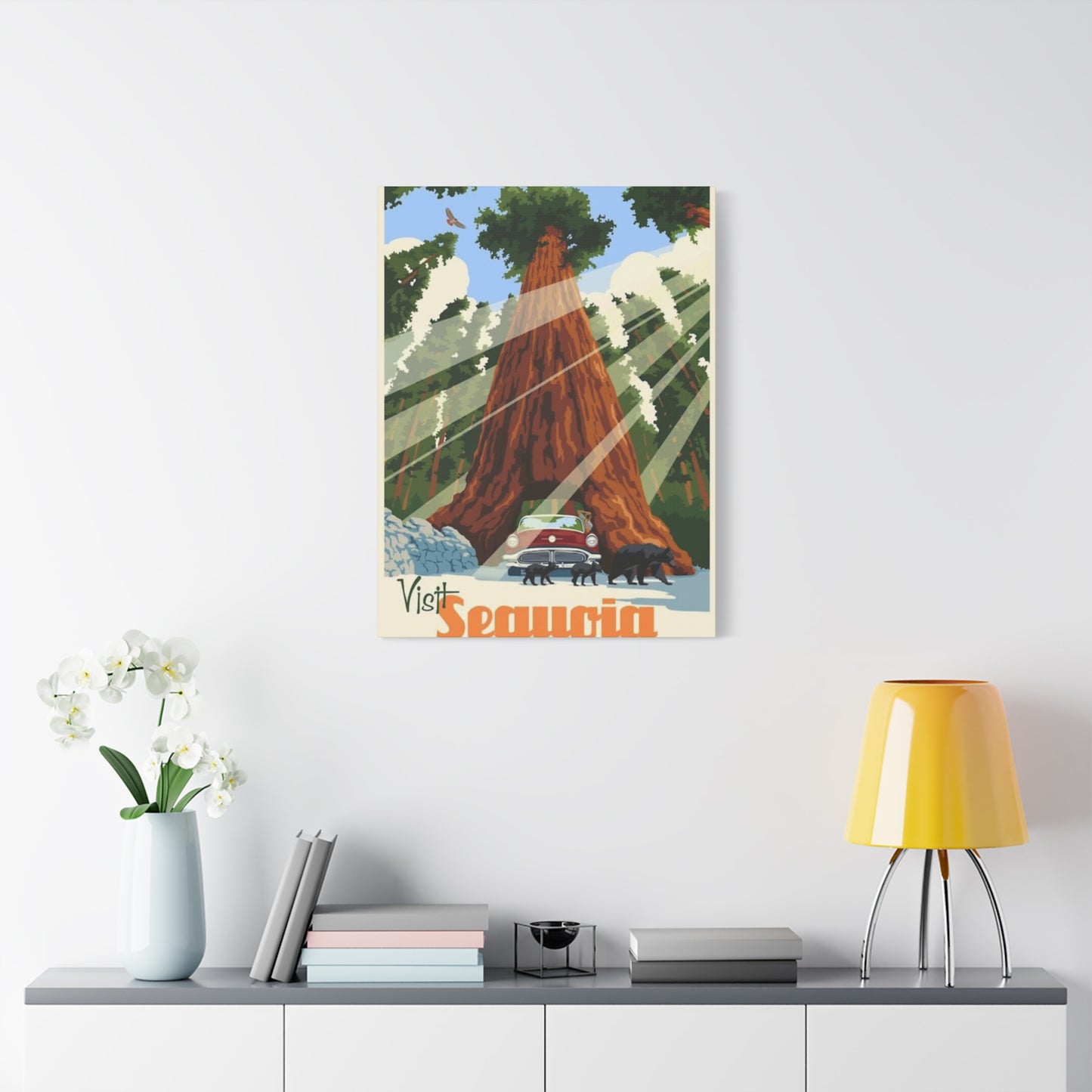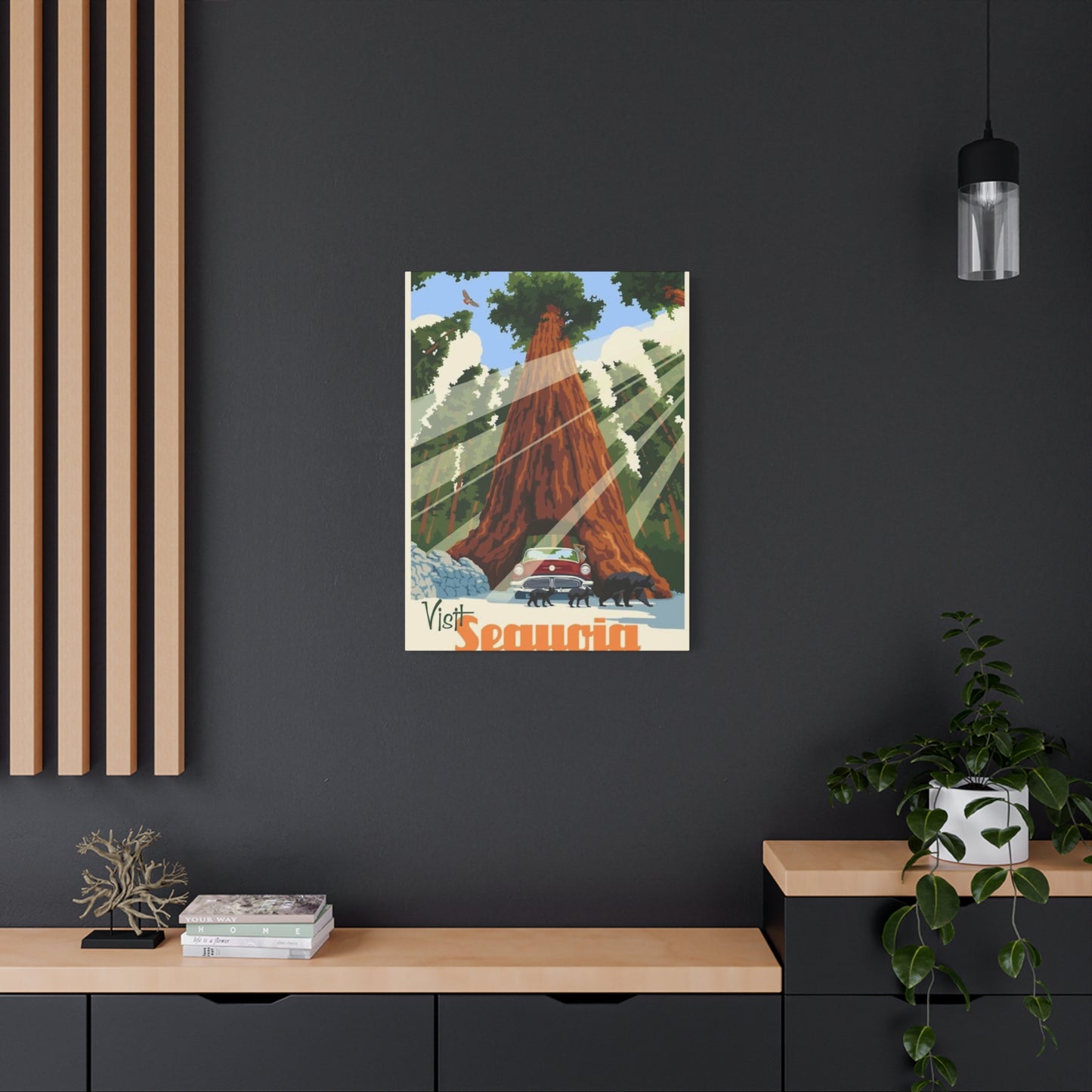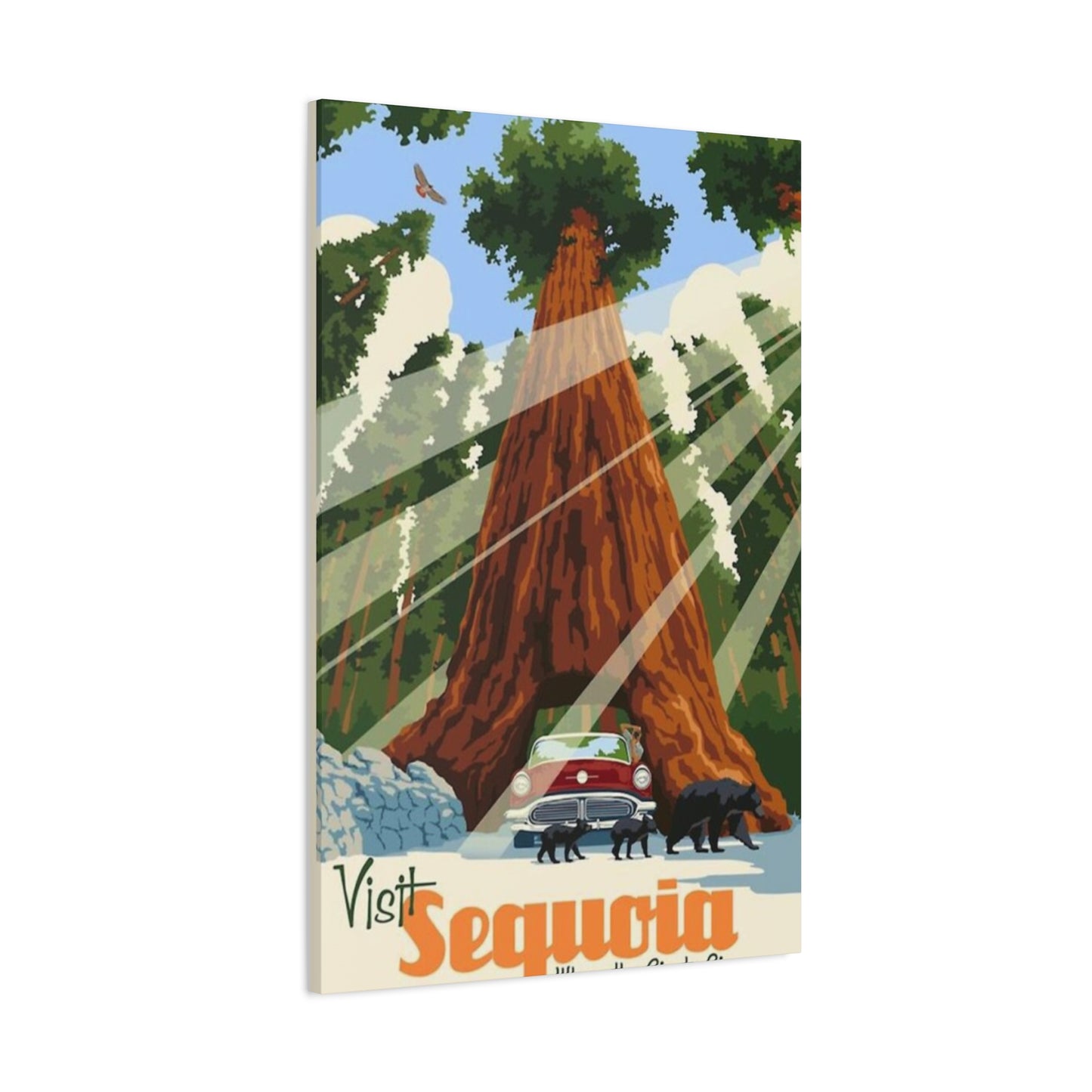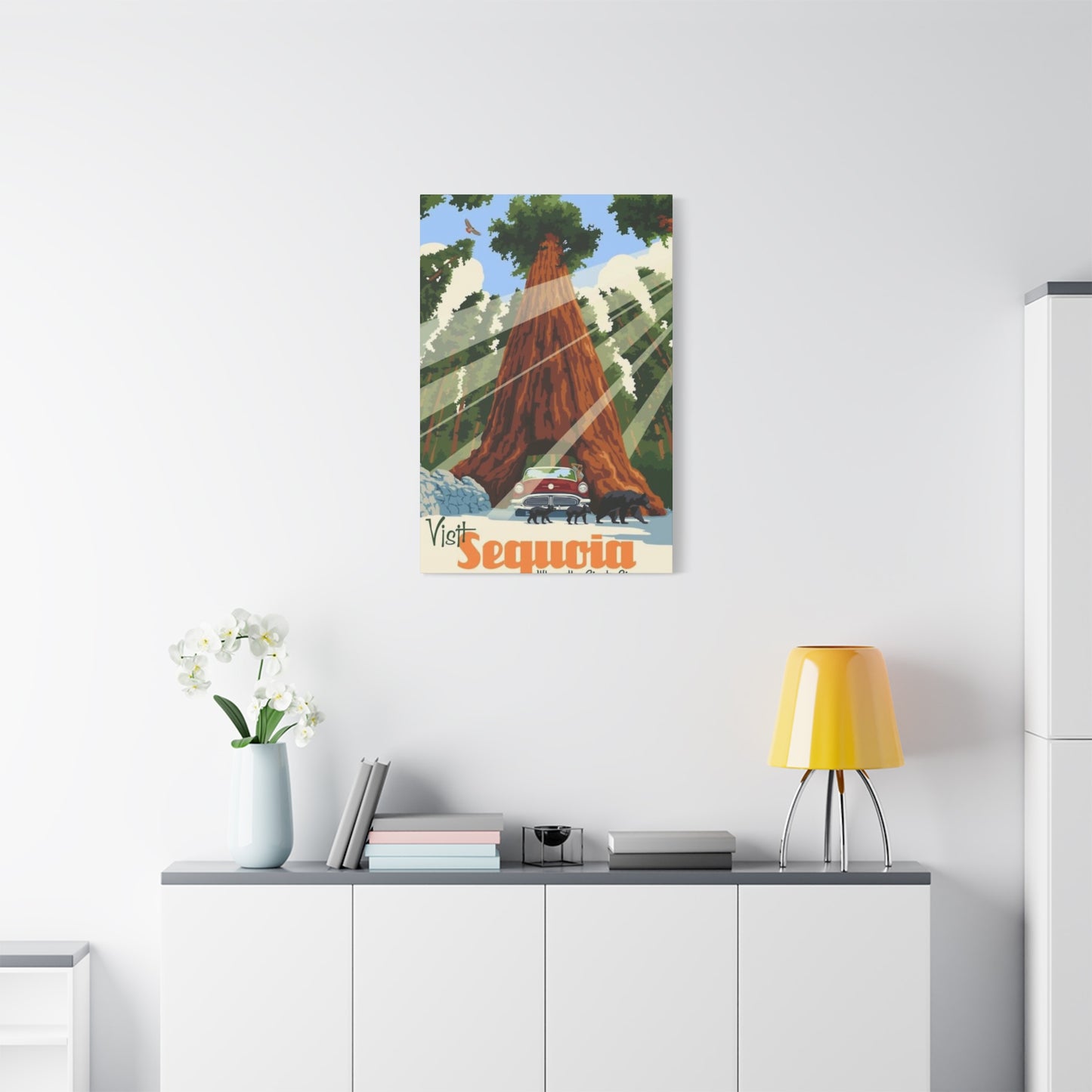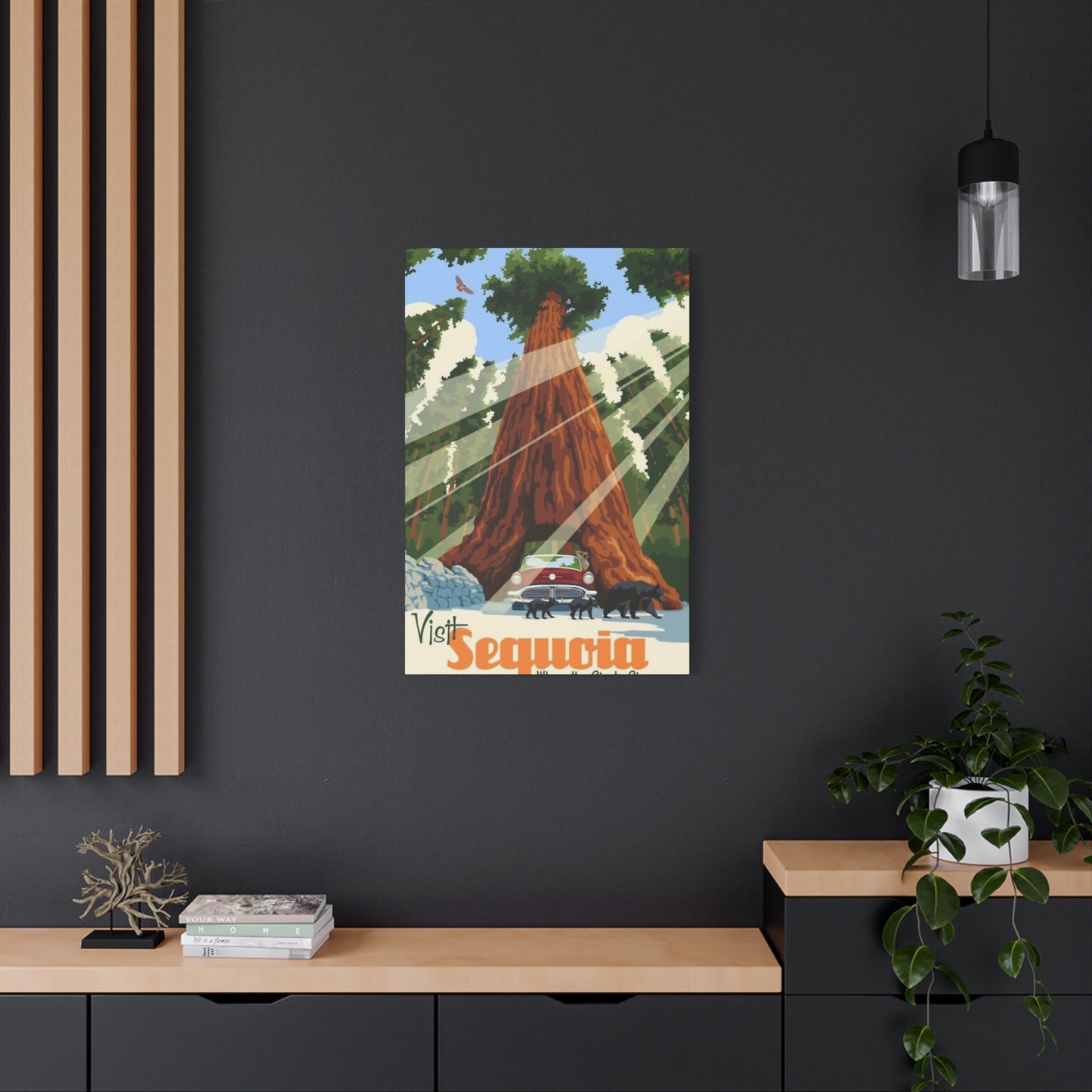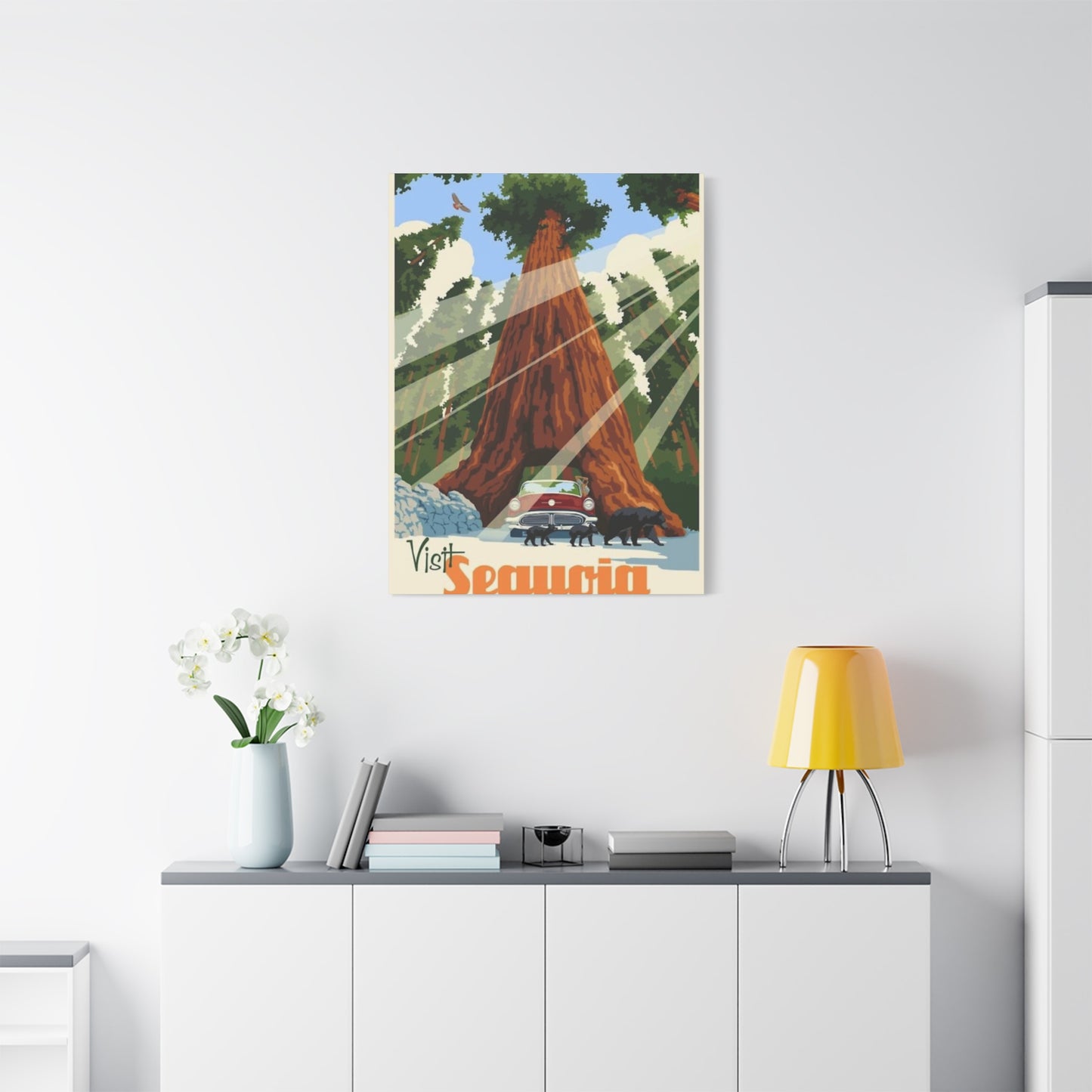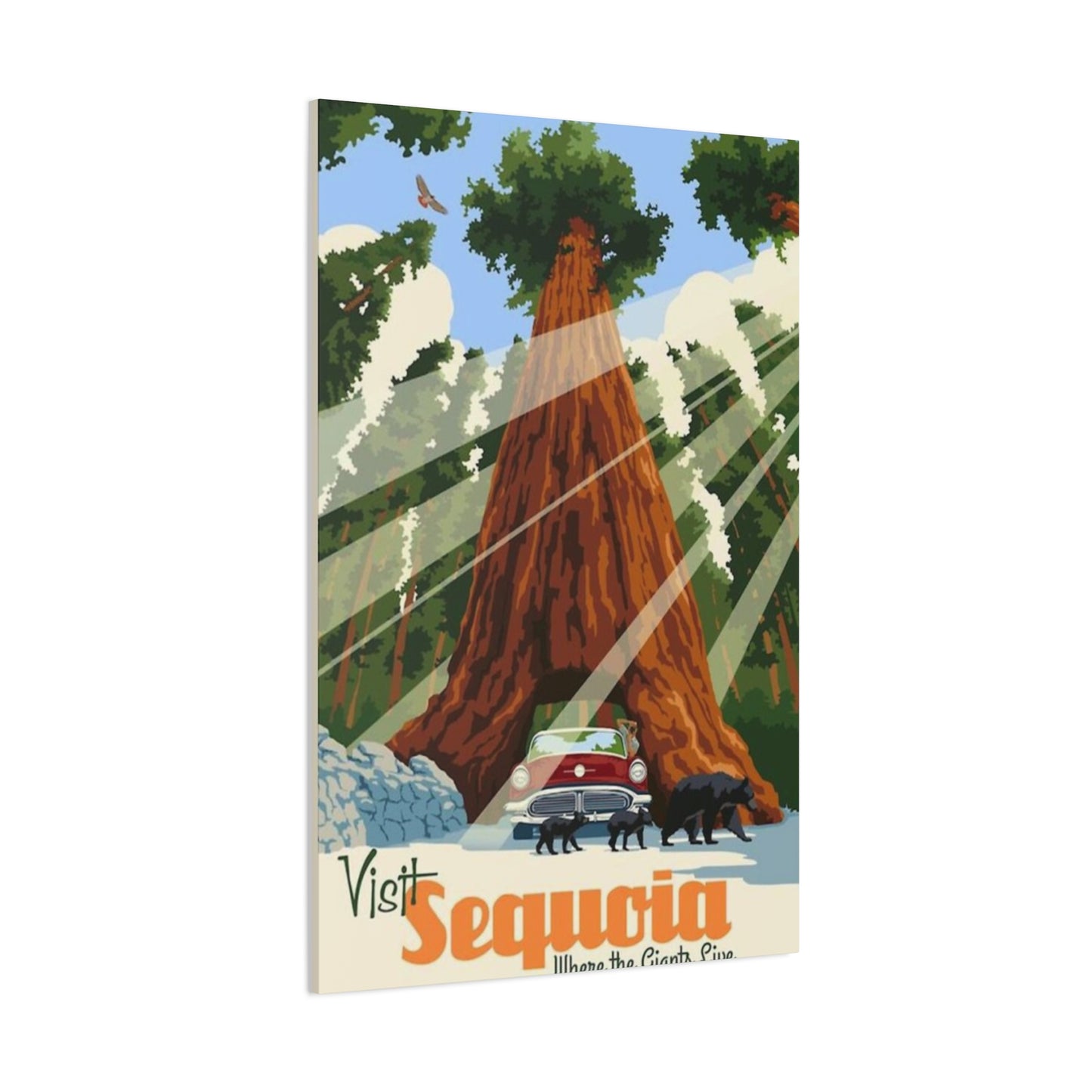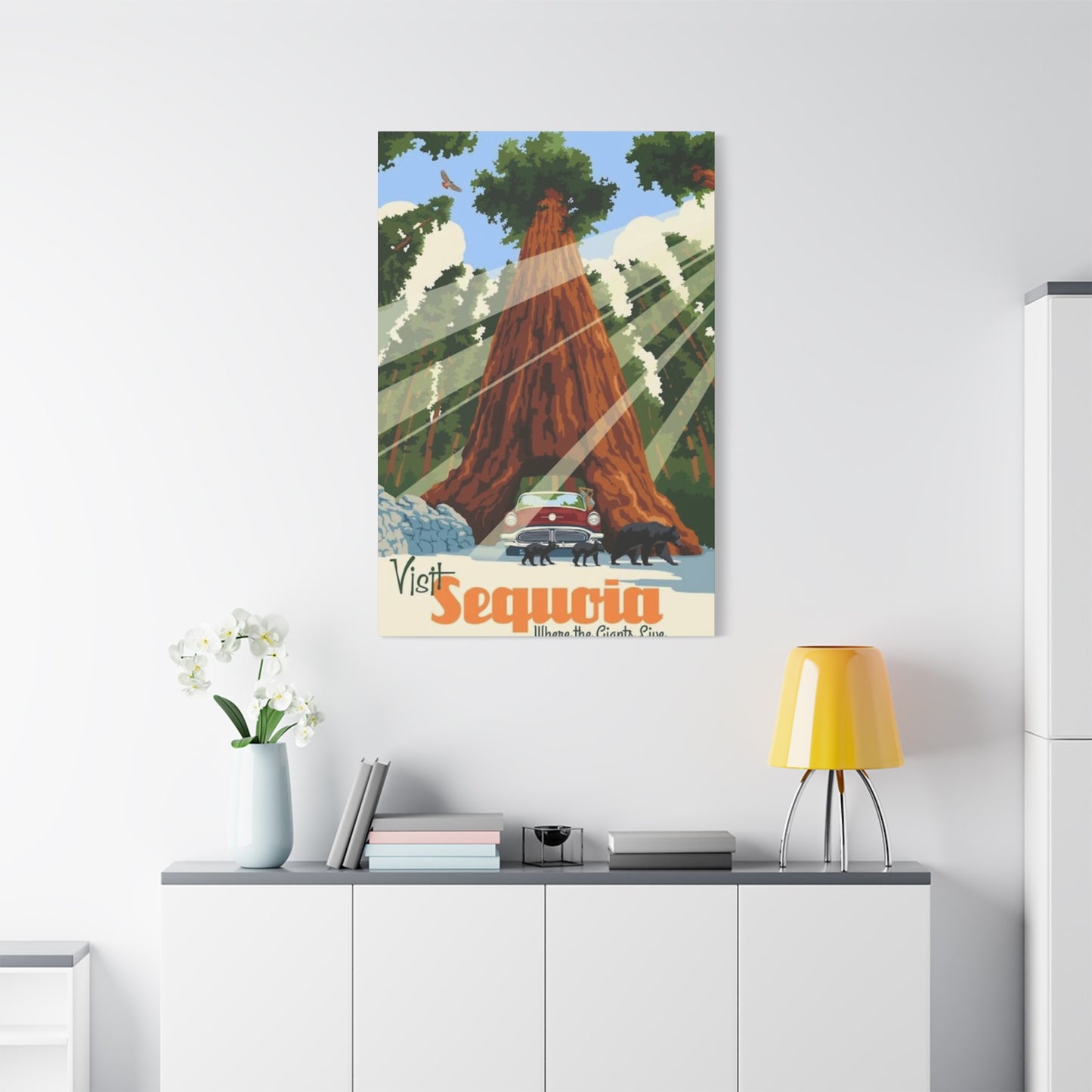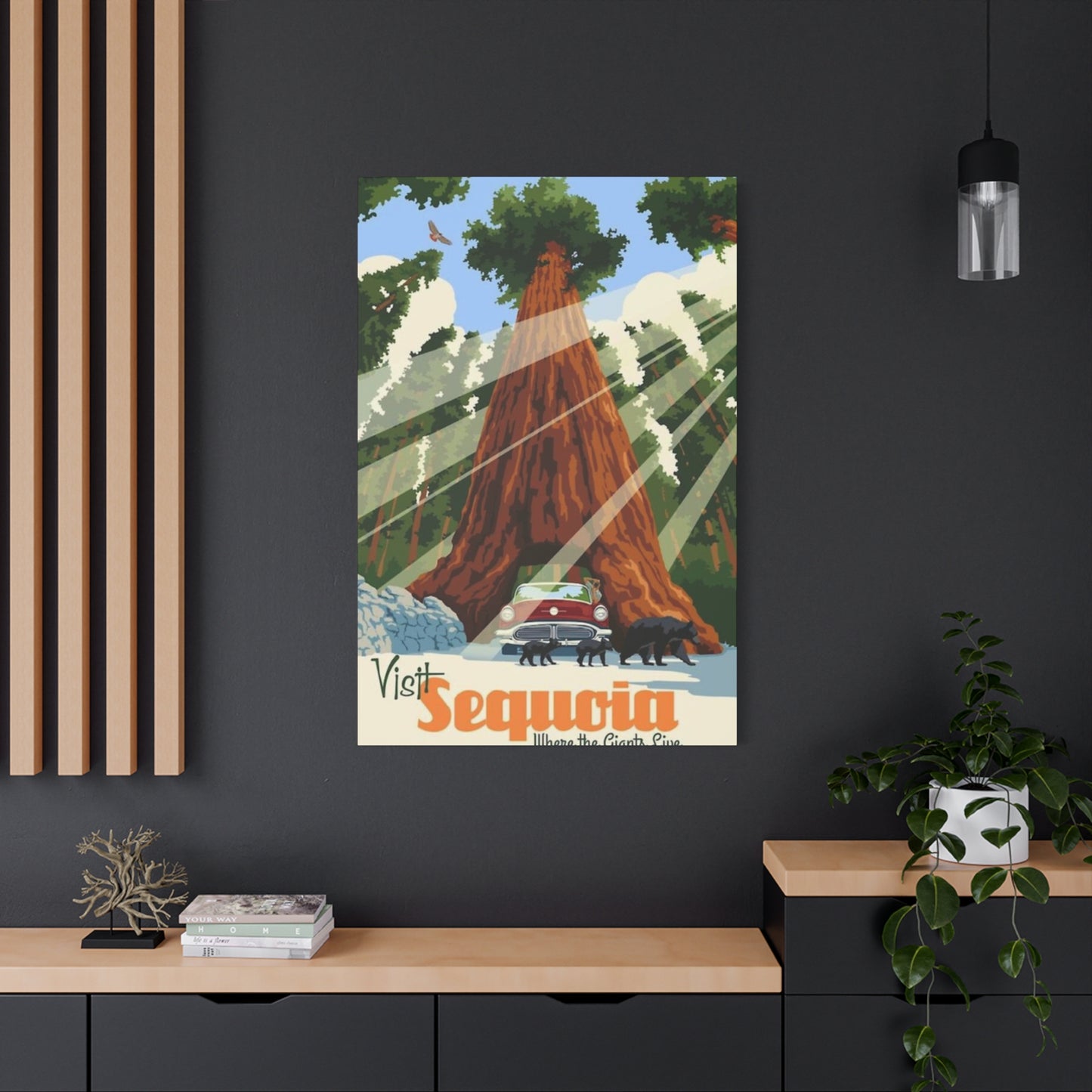Sequoia National Park Wall Art: Elevate Your Living Space with Forest-Inspired Decor
Decorating your living space with artwork inspired by one of America's most magnificent natural treasures has become a widespread trend among homeowners and interior design enthusiasts. The towering giants of these ancient forests offer a visual connection to nature that transforms ordinary rooms into peaceful sanctuaries. When you hang artwork featuring these majestic trees on your walls, you're not just adding decoration; you're creating an atmosphere that promotes tranquility and brings the grandeur of the wilderness directly into your daily environment.
The appeal of forest-themed artwork extends far beyond simple aesthetics. These pieces serve as daily reminders of the natural world's beauty, offering a visual escape from urban environments and busy lifestyles. The vertical lines of towering trees create a sense of height and spaciousness in rooms, while the earthy tones and organic forms introduce warmth and authenticity to modern interiors. Whether you're drawn to panoramic landscapes, close-up views of textured bark, or misty forest scenes, incorporating these natural elements into your home design creates a harmonious balance between contemporary living and timeless natural beauty.
The Rising Appeal of National Park Artwork in Home Design
The growing popularity of artwork featuring America's protected wilderness areas reflects a broader cultural shift toward biophilic design and nature-inspired living spaces. More people are seeking ways to incorporate organic elements into their homes, recognizing the psychological benefits of maintaining visual connections to the natural environment. Artwork depicting ancient forests, towering conifers, and preserved landscapes satisfies this desire by bringing outdoor scenery into indoor spaces where we spend most of our time.
Several factors contribute to this trend's momentum. First, there's an increasing awareness of environmental conservation and appreciation for protected natural areas. Displaying artwork that celebrates these locations demonstrates personal values and creates conversation starters about conservation efforts. Second, the rise of remote work has made people more conscious of their home environments, leading them to invest in decor that promotes wellbeing and productivity. Third, social media platforms have amplified the visibility of beautifully designed interiors, inspiring homeowners to recreate similar aesthetics in their own spaces.
The visual characteristics of forest landscapes make them particularly suitable for home decoration. The vertical emphasis of tall trees draws the eye upward, creating an illusion of higher ceilings and more spacious rooms. The natural color palette, ranging from deep greens to warm browns and soft grays, complements virtually any interior color scheme. The organic textures and patterns found in bark, foliage, and forest floors add visual interest without overwhelming a space. These qualities make nature-themed artwork versatile enough for various design styles, from rustic farmhouse to sleek contemporary.
Additionally, the timeless quality of forest imagery ensures that these decorative pieces remain relevant through changing design trends. Unlike trendy artwork that may feel dated after a few years, representations of ancient trees and wilderness landscapes maintain their appeal across generations. This longevity makes them wise investment pieces for homeowners who want decor that will grow with their evolving tastes rather than requiring frequent replacement.
Creating Natural Ambiance Through Forest-Themed Wall Displays
Transforming your living space into a nature-inspired haven begins with selecting the right wall displays that resonate with your personal aesthetic and the mood you wish to create. Forest-themed artwork serves as an anchor point for entire room designs, influencing everything from furniture selection to accessory choices. When you introduce imagery of towering conifers and ancient woodlands into your home, you establish an immediate connection to the tranquility and grandeur of natural environments.
The psychological impact of displaying nature scenes in your home extends beyond simple visual pleasure. Research in environmental psychology has demonstrated that exposure to natural imagery can reduce stress levels, improve mood, and enhance cognitive function. When you position artwork featuring forest landscapes in frequently used spaces like living rooms, bedrooms, or home offices, you create opportunities for brief mental escapes throughout your day. These moments of visual connection to nature can lower blood pressure, decrease anxiety, and promote overall wellbeing.
Consider the placement of your forest-themed artwork carefully to maximize its impact. In living rooms, large-scale pieces above sofas or fireplaces become focal points that draw attention and anchor seating arrangements. In bedrooms, positioning calming forest scenes across from the bed allows them to be the first thing you see upon waking and the last before sleeping, bookending your day with peaceful imagery. Home offices benefit from nature-themed artwork positioned within your line of sight, providing visual breaks during work sessions that can boost creativity and reduce mental fatigue.
Strategies for Incorporating Woodland Imagery into Various Design Schemes
Successfully integrating forest-inspired prints into your existing decor requires understanding how these natural elements interact with different interior design styles. The versatility of woodland imagery means it can adapt to various aesthetic approaches, from traditional to contemporary, provided you make thoughtful choices about presentation, framing, and complementary elements.
In rustic or farmhouse-style interiors, forest-themed artwork feels particularly at home. The organic subject matter aligns naturally with the emphasis on natural materials and textures characteristic of these design approaches. Choose pieces with earthy color palettes and pair them with wooden frames in natural finishes or distressed textures. Surround your artwork with complementary elements like reclaimed wood shelving, woven baskets, and natural fiber textiles to create cohesive, nature-inspired vignettes. The key is maintaining authenticity by selecting artwork with realistic representations rather than overly stylized interpretations.
Modern and contemporary spaces benefit from forest imagery presented in clean, minimalist ways. Select pieces with strong compositional elements, such as striking vertical lines of tree trunks or high-contrast black and white forest scenes. Frame these works in simple, sleek frames with minimal ornamentation, allowing the artwork itself to command attention. In modern interiors, less is often more, so consider featuring a single large-scale piece rather than multiple smaller works. The juxtaposition of organic natural forms against clean architectural lines creates dynamic visual tension that defines sophisticated contemporary design.
Scandinavian or Nordic-inspired interiors provide an ideal backdrop for forest-themed artwork, as this design philosophy inherently embraces nature and natural light. Choose pieces featuring misty forests, birch groves, or snow-dusted conifers that reflect the Nordic landscape. Pair these works with the characteristic Scandinavian color palette of whites, grays, and soft blues, with occasional warm wood tones. The hygge concept central to Scandinavian design emphasizes coziness and comfort, which forest imagery naturally enhances by creating visual warmth and connection to the outdoors.
Canvas Artwork Featuring Ancient Forest Giants
Canvas prints depicting towering forest giants offer a unique combination of visual impact and affordability that has made them increasingly popular among homeowners and renters alike. The texture and depth of canvas as a medium particularly suits forest imagery, lending a tactile quality that enhances the organic nature of the subject matter. When light falls across a canvas surface, the subtle texture creates shadows and highlights that add dimensionality to the printed image, bringing the forest scene to life in ways that flat paper prints cannot replicate.
The production quality of modern canvas prints has reached impressive levels, with high-resolution printing techniques capturing extraordinary detail in bark textures, light filtering through canopies, and the subtle color variations found in natural forest environments. Giclée printing processes using archival inks ensure that these pieces maintain their color vibrancy for decades, making them lasting investments in your home decor. The UV-resistant properties of quality canvas prints mean they can withstand exposure to indirect sunlight without significant fading, an important consideration for pieces displayed in naturally lit rooms.
Stretched canvas prints offer a contemporary presentation style that eliminates the need for traditional framing. The image wraps around the edges of the wooden stretcher bars, creating a three-dimensional object that appears to float slightly away from the wall when hung. This gallery-wrap style suits modern and contemporary interiors particularly well, contributing to the clean, uncluttered aesthetic these design approaches favor. The absence of glass or acrylic covering means there's no glare to interfere with viewing the artwork from different angles or in various lighting conditions.
For those who prefer a more traditional presentation, canvas prints can certainly be framed. A floating frame, which surrounds the canvas while leaving a small gap between the artwork and the frame, offers an elegant compromise between framed and unframed presentations. This approach adds a finished, polished look while maintaining the textural appeal of the canvas surface. Traditional frames with mat boards can also work, though this treatment may diminish some of the dimensional quality that makes canvas such an appealing medium for forest imagery.
Benefits of Choosing Forest-Themed Artwork for Interior Spaces
Selecting artwork that features ancient forests and towering conifers for your home decor offers numerous advantages that extend beyond simple aesthetics. These pieces serve multiple functions, from psychological benefits to practical decorating solutions, making them smart choices for thoughtful homeowners.
The biophilic design principle, which emphasizes human connections to nature in built environments, provides the foundation for understanding why forest-themed artwork proves so beneficial. Studies have shown that incorporating natural elements into interior spaces, even through representational imagery, can reduce stress hormones, lower heart rate, and improve overall mood. When you display forest scenes in your home, you create a visual sanctuary that provides respite from the demands and artificiality of modern life. This psychological benefit becomes particularly valuable in urban environments where direct access to nature may be limited.
From a purely decorative standpoint, forest-themed artwork offers remarkable versatility in color and composition. The natural palette of forests includes countless shades of green, brown, gray, and blue, all of which coordinate effortlessly with most interior color schemes. Whether your walls are painted in cool neutrals, warm earth tones, or bold accent colors, forest imagery typically harmonizes without clashing. This flexibility means you can change other elements of your room decor without needing to replace your artwork, providing long-term value and reducing the need for frequent redecorating.
The vertical emphasis inherent in depictions of tall trees creates valuable visual effects in interior spaces. Vertically oriented artwork draws the eye upward, creating an illusion of higher ceilings and more spacious rooms. This makes forest-themed pieces particularly effective in rooms with standard eight-foot ceilings or in smaller spaces where you want to maximize the sense of openness. The upward movement suggested by towering trees can make rooms feel more expansive and airy, counteracting the potentially cramped feeling of limited square footage.
Forest artwork also serves as an excellent conversation starter and reflection of personal values. Guests often comment on striking nature-themed pieces, creating opportunities to discuss your appreciation for wilderness areas, conservation efforts, or memorable visits to natural landmarks. This social dimension adds depth to your decor choices, transforming them from purely aesthetic decisions into expressions of identity and values. For environmentally conscious individuals, displaying forest imagery reinforces their commitment to nature preservation and can inspire discussions about environmental stewardship.
Introducing Wilderness Character to Interior Environments
The concept of bringing outdoor environments into your living space transcends mere decoration, representing a lifestyle choice that prioritizes connection with nature even within built environments. Forest-themed wall artwork serves as a bridge between the indoor and outdoor worlds, allowing you to maintain visual contact with natural landscapes regardless of your physical location or the season outside your windows.
This approach to interior design recognizes that humans evolved in natural environments and retain innate responses to natural imagery and patterns. When you surround yourself with representations of forests and wilderness, you tap into these deep-seated connections, creating spaces that feel inherently comfortable and restorative. The presence of forest imagery can make artificial indoor environments feel more balanced and harmonious, reducing the sense of disconnection that sometimes accompanies modern urban living.
The specific qualities of forest scenes make them particularly effective at creating the illusion of expanded space and connection to outdoors. Depth in landscape compositions draws the viewer's eye into the image, creating a sense of three-dimensional space that seems to extend beyond the physical wall. This perceptual effect can make rooms feel larger and less confined, particularly valuable in apartments or homes with limited square footage. Strategically positioning forest artwork opposite windows or doorways enhances this effect by creating visual pathways that link indoor and outdoor spaces.
Seasonal variations in forest imagery allow you to rotate artwork throughout the year, maintaining freshness in your decor while celebrating the changing seasons. Spring forest scenes featuring new growth and dappled sunlight can refresh your space after winter. Summer images of lush, full canopies bring energy and vitality to your rooms. Autumn forest scenes with golden foliage add warmth and richness as days grow shorter. Winter forest landscapes with snow-covered branches create serene, contemplative atmospheres. This rotation keeps your decor dynamic and connected to the natural rhythms that govern the world outside your walls.
Combining forest artwork with natural materials in your furniture and accessories amplifies the indoor-outdoor connection. Wooden furniture pieces, stone accessories, natural fiber textiles, and living plants all work synergistically with forest-themed wall art to create cohesive nature-inspired interiors. The interplay between two-dimensional representations of nature on your walls and three-dimensional natural materials in your furnishings creates rich, layered environments that engage multiple senses and reinforce the connection to outdoor spaces.
Consider how different forest environments represented in your artwork can evoke distinct feelings and atmospheres. Dense, old-growth forests with massive tree trunks create feelings of permanence, stability, and awe. Open woodlands with filtered light suggest hope, growth, and possibility. Misty forest scenes evoke mystery and contemplation. Mountain forests convey strength and endurance. By selecting specific types of forest imagery, you can fine-tune the emotional atmosphere of your spaces to align with their intended purposes and your desired experiences within them.
Achieving Rustic Aesthetics with Forest-Inspired Canvas Artwork
The rustic interior design style and forest-themed canvas artwork form a natural partnership, as both emphasize authenticity, natural materials, and connections to rural or wilderness environments. When executed thoughtfully, this combination creates warm, inviting spaces that feel grounded and unpretentious while maintaining visual sophistication.
Authentic rustic design celebrates the beauty of imperfection and the character that comes with age and use. Canvas prints featuring ancient forests align perfectly with this philosophy, as they depict subjects that embody longevity, weathering, and natural processes. The textured surface of canvas complements rustic interiors by adding tactile dimension without introducing overly refined or polished elements that might disrupt the casual, lived-in feeling these spaces cultivate.
Selecting the right forest imagery for rustic interiors requires attention to both subject matter and treatment. Photographs or artwork depicting old-growth forests with massive, gnarled trunks and evidence of age resonate particularly well with rustic aesthetics. Images showing fallen logs, textured bark, or forests in various stages of growth and decay reflect the rustic appreciation for natural processes and the passage of time. Avoid overly manicured or idealized forest scenes in favor of representations that capture the raw, unedited beauty of wilderness areas.
Color palette choices significantly impact how forest artwork integrates into rustic spaces. Warm-toned images featuring rich browns, golden greens, and amber sunlight complement the wood-heavy color schemes typical of rustic interiors. Sepia-toned or vintage-style forest photography can enhance the nostalgic quality that often characterizes rustic design. Black and white forest imagery works well too, particularly when it emphasizes texture and contrast through strong compositional elements like dramatic lighting or weather effects.
Framing choices for rustic interiors should emphasize natural materials and simple construction. Reclaimed wood frames with visible grain, knots, and natural color variation perfectly complement both forest-themed subject matter and rustic design principles. Barn wood frames add authentic rural character, while rough-hewn frames suggest hand-crafted quality. Avoid ornate or gilded frames that introduce formality incompatible with rustic aesthetics. If you prefer unframed canvas, the gallery-wrap style works well, particularly when the canvas edges are finished in neutral colors that blend with log or wood-paneled walls.
Showcasing Renowned Natural Landmarks on Your Walls
Displaying artwork that features specific protected wilderness areas and national treasures allows you to celebrate places that hold cultural, environmental, and personal significance. These locations represent more than beautiful scenery; they embody conservation success stories, national heritage, and the enduring appeal of preserved wild spaces. When you hang such imagery in your home, you participate in a broader cultural conversation about the value of protecting natural areas for future generations.
The visual distinctiveness of different protected areas makes them recognizable even to those who haven't visited in person. The iconic silhouettes of giant sequoias, the distinctive shapes of ancient conifers, and the characteristic landscapes of various wilderness areas create immediately identifiable imagery that carries specific associations and meanings. This recognizability adds an extra dimension to your decor, transforming generic nature imagery into specific place-based art that tells stories and evokes particular locations.
For those who have personally visited these remarkable places, artwork depicting them serves as powerful memory triggers and meaningful souvenirs. Unlike generic vacation trinkets, high-quality artwork featuring locations you've explored creates lasting connections to meaningful experiences. Each viewing can transport you back to moments spent walking among towering trees, breathing fresh mountain air, or experiencing the profound quiet of old-growth forests. These emotional connections make the artwork more valuable and personally significant than pieces chosen purely for aesthetic reasons.
Even for those who haven't yet visited these protected areas, displaying their imagery can serve as aspirational decor that represents future travel goals and bucket-list destinations. The artwork becomes a daily reminder of places you hope to explore, keeping those aspirations visible and present in your consciousness. This forward-looking dimension adds purpose to your decorating choices, making them expressions of values and dreams rather than purely aesthetic decisions.
The educational value of location-specific artwork extends to family members and guests who may be unfamiliar with these remarkable places. Your pieces can spark conversations about geography, ecology, conservation history, and travel experiences. Children growing up with images of significant natural areas on their walls develop early awareness of these places and their importance, potentially fostering lifelong interests in nature and conservation. The artwork serves as a jumping-off point for research, documentaries, books, and eventually, personal visits.
Consider creating dedicated gallery walls or groupings that tell comprehensive visual stories about specific locations. Combine images showing different perspectives, seasons, or features of the same area to create more complete representations. Mix panoramic vistas with detail shots of bark, flora, or wildlife to capture both the grand scale and intimate beauty of these environments. Include vintage-style artwork or historical photographs alongside contemporary images to illustrate how these places have been preserved over time, adding a historical dimension to your display.
Contemporary Wall Decor Drawing from Ancient Forest Inspiration
Modern design aesthetics and ancient forest imagery might seem contradictory at first glance, but their combination creates striking, sophisticated interiors that balance natural elements with contemporary sensibilities. The key lies in how forest themes are interpreted, presented, and integrated into spaces characterized by clean lines, minimal ornamentation, and carefully curated elements.
Contemporary forest artwork often features bold compositional choices that emphasize graphic qualities over purely representational approaches. High-contrast black and white forest photography, extreme close-ups of bark textures, or abstract interpretations of forest patterns align well with modern design's appreciation for strong visual statements. These treatments transform familiar natural subjects into contemporary art pieces that hold their own in design-forward spaces.
Geometric cropping and unusual aspect ratios give forest imagery modern edge. Extreme panoramas, vertical banners, or square formats present familiar forest scenes in unexpected ways that challenge traditional landscape orientation conventions. These non-standard presentations signal contemporary sensibilities while maintaining connection to natural subject matter. Large-scale prints in these formats create dramatic focal points that define modern interiors.
Minimalist presentation styles suit contemporary spaces perfectly. Gallery-wrapped canvases without frames offer clean, architectural qualities that complement modern design's emphasis on form and material honesty. The three-dimensional quality of stretched canvas aligns with contemporary art presentation standards while the exposed canvas edges create shadow lines that add subtle visual interest to otherwise flat walls. This approach eliminates the decorative elements of traditional framing that might introduce unwanted ornamentation into modern spaces.
Monochromatic or limited color palette forest imagery maintains visual simplicity appropriate for contemporary interiors. Black and white forest photography emphasizes tonal values, textures, and compositional strength without color distractions. Alternatively, duotone treatments that combine forest imagery with single accent colors create bold, graphic effects that resonate with modern design's color discipline. These restrained approaches prevent forest artwork from overwhelming carefully balanced contemporary color schemes.
The negative space in contemporary design provides ideal backdrops for forest artwork to make maximum impact. Placing a single striking forest image on an otherwise empty wall creates the kind of focused, intentional composition that defines successful modern interiors. Resisting the urge to fill every wall and leaving substantial breathing room around your forest artwork allows each piece to be fully appreciated and prevents visual clutter that undermines contemporary aesthetics.
Forest Imagery as Living Room Statement Pieces
The living room serves as the primary social and relaxation space in most homes, making it an ideal location for significant artwork that sets tone, sparks conversation, and expresses personal style. Forest-themed canvas prints in living rooms create focal points that anchor furniture arrangements while introducing natural beauty and calming influences to spaces where families gather and guests are entertained.
Positioning canvas prints above sofas represents the most common and effective living room arrangement. The horizontal emphasis of most seating furniture pairs naturally with landscape-oriented forest scenes, creating balanced compositions that feel stable and intentional. The artwork should span roughly two-thirds the width of the sofa below it, creating visual connection without overwhelming the space. Leave approximately six to eight inches between the sofa back and the bottom edge of the artwork to establish appropriate visual relationship.
Alternative positioning over fireplaces takes advantage of the architectural focal point that hearths naturally create. Forest artwork above mantels combines two strong focal elements, reinforcing their importance and creating undeniable room anchors. This placement works particularly well with rustic or traditional design schemes where fireplaces play central roles in room layouts and seasonal use. The natural association between forests and firewood creates thematic coherence between the artwork and the functional fireplace below.
Gallery wall arrangements featuring multiple forest-themed pieces allow for more dynamic, personalized displays that tell visual stories about your relationship with nature. Combine different forest perspectives, seasons, and scales to create collections that reward extended viewing and reveal new details over time. Mix vertical and horizontal orientations, vary frame sizes slightly, and include both wide vistas and intimate detail shots to build visual interest and prevent monotony.
Expansive Tree Imagery in Wide-Format Presentations
Panoramic forest compositions offer unique opportunities to capture the sweeping grandeur of woodland environments in ways that standard aspect ratios cannot achieve. These wide-format pieces stretch across walls, creating immersive views that transport viewers into depicted scenes and emphasize the horizontal expanse of forest landscapes.
The extreme width of panoramic formats naturally suits certain architectural features and furniture arrangements. Above king-sized beds, long sofas, or extended dining tables, panoramic forest artwork creates visual balance by matching the horizontal emphasis of these furniture pieces. The proportion relationship feels intuitive and harmonious, avoiding the awkward gaps or visual imbalance that can result from mismatched artwork and furniture scales.
Panoramic compositions excel at capturing specific forest experiences that benefit from wide perspectives. Sunrise or sunset views with light streaming horizontally through tree trunks gain drama and impact from extended width. Rows of trees lining paths or roads that recede into the distance emphasize depth and draw viewers into the scene. Wide vistas showing forest edges meeting meadows or lakes benefit from panoramic treatment that captures the full breadth of the landscape transition.
Multi-panel panoramic installations divided into two, three, or more sections offer flexibility in how you approach wide-format forest artwork. Triptychs featuring forest scenes split across three canvases create dynamic presentations with visual rhythm and movement. The gaps between panels add a contemporary edge while breaking up what might otherwise feel like overwhelming single images. These multi-panel approaches also simplify handling and installation compared to single extremely wide canvases.
Consider the viewing distance when selecting panoramic forest artwork for specific locations. Pieces installed in rooms where viewers typically stand relatively close need sufficient detail to reward close examination. From typical viewing distances of six to eight feet, you should be able to discern individual leaves, bark texture, and other fine details that create engaging viewing experiences. Conversely, panoramic pieces intended for viewing across larger rooms can emphasize overall composition and mood over minute detail.
Current Movements in Protected Landscape Canvas Art
The market for artwork featuring America's treasured wilderness areas continues to evolve, reflecting broader shifts in design sensibilities, printing technologies, and cultural attitudes toward nature and conservation. Understanding these trends helps you select pieces that feel contemporary while maintaining the timeless appeal that makes nature artwork eternally relevant.
The movement toward larger-scale artwork has accelerated in recent years as printing technologies improve and homeowners seek statement pieces that transform spaces dramatically. Where once a 24 by 36 inch print might have been considered substantial, contemporary tastes increasingly favor pieces measuring four, five, or even six feet in width. These monumental scales create immersive viewing experiences that transport viewers into depicted scenes in ways smaller prints cannot achieve. The trend reflects both the technical feasibility of producing large-format prints with excellent quality and cultural shifts toward bolder, more confident decorating choices.
Minimalist and unframed presentations continue gaining popularity, particularly among younger homeowners and those with contemporary design preferences. Gallery-wrapped canvases without additional framing create clean, modern looks that eliminate the visual weight and stylistic complications of frames. This approach also reduces costs and simplifies installation, practical considerations that appeal to budget-conscious decorators and frequent movers. The trend toward minimal presentation emphasizes the artwork itself rather than its packaging, allowing powerful imagery to speak without decorative embellishment.
Black and white forest photography has experienced a renaissance as homeowners and designers appreciate its timeless sophistication and versatility. Monochromatic forest scenes coordinate with any color scheme while maintaining dramatic impact through tonal contrast and compositional strength. The absence of color information focuses attention on form, texture, and light quality, often revealing aspects of forest landscapes that color might obscure. This trend connects to broader movements in fine art photography and demonstrates how traditional approaches remain relevant when executed with contemporary technical excellence.
Sustainable and eco-conscious production methods increasingly influence purchasing decisions as consumers become more environmentally aware. Canvas prints produced using water-based inks, sustainably sourced materials, and carbon-neutral shipping appeal to buyers who want their decor choices to align with conservation values. Some producers partner with conservation organizations, donating portions of proceeds to protect the very landscapes depicted in their artwork. This trend reflects growing recognition that consumption choices, including decorative purchases, carry environmental and ethical dimensions.
Forest-Themed Art as Ideal Presents for Outdoor Enthusiasts
Selecting gifts that truly resonate with recipients requires understanding their interests, values, and aesthetic preferences. For individuals who love spending time outdoors, hiking, camping, or simply appreciating natural beauty, forest-themed artwork makes thoughtful, meaningful presents that demonstrate your awareness of their passions.
The personal significance of location-specific artwork makes it particularly valuable as a gift. If you know the recipient has visited or dreams of visiting specific national parks or wilderness areas, artwork featuring those locations carries extra meaning. The piece serves as a memory of past experiences or inspiration for future adventures, creating emotional connections beyond simple aesthetic appreciation. This personalized dimension transforms the gift from generic decor into something specifically chosen for the recipient.
Forest artwork functions as a gift that continues giving value over years or decades of display. Unlike consumable gifts that are used up or clothing that wears out, quality artwork remains a constant presence in recipients' homes, providing daily enjoyment and serving as an ongoing reminder of the giver. This lasting quality makes artwork gifts particularly meaningful for significant occasions like weddings, housewarmings, or milestone birthdays when you want to mark the importance of the event with something substantial and enduring.
The universality of nature appreciation means forest artwork carries low risk of being rejected or disliked based on personal taste variations. While specific frame styles or color preferences might vary, the fundamental appeal of beautiful forest imagery remains remarkably consistent across individuals. This makes nature-themed artwork a safer gift choice than more subjective options like abstract art, pop culture references, or trendy designs that might not align with the recipient's particular tastes.
Gift-giving occasions often involve practical constraints around portability and presentation. Rolled canvas prints ship easily and cost-effectively, making them practical gifts for recipients who live far away. The rolled format also creates element of surprise, as the full impact of the artwork isn't revealed until the recipient unrolls and hangs it. Many online retailers offer gift wrapping, direct shipping to recipients, and gift messages, simplifying the logistics of giving artwork as presents.
Custom framing services allow you to present forest artwork ready to hang, eliminating the task of frame selection and mounting for recipients. This white-glove approach suits gifts for elderly relatives, busy professionals, or anyone who might appreciate having the complete package ready for immediate installation. While more expensive than unframed prints, the convenience and finished presentation justify the investment for important gift-giving occasions.
Presentation Strategies for Large-Scale Forest Artwork
Successfully framing and displaying substantial forest prints requires attention to technical details that ensure your artwork looks professional, remains secure, and receives appropriate protection. While smaller pieces forgive casual approaches, large-format works demand more careful consideration of materials, methods, and placement.
Frame selection for oversized forest artwork should balance aesthetic preferences with structural requirements. Large pieces need substantial frames capable of supporting significant weight without warping or sagging. Wood frames with reinforced corners and proper backing provide necessary stability. Metal frames offer strength with minimal visual bulk, suiting contemporary presentations. Regardless of material, ensure frame components are properly sized for the artwork dimensions; using standard-size frames for custom-size prints rarely produces satisfactory results.
Mat boards create visual breathing room between artwork and frames while adding layers that enhance three-dimensional presence. For large forest prints, wider mats, measuring three to four inches on all sides, prevent the artwork from appearing cramped within its frame. Choose mat colors that complement the forest imagery without competing for attention; neutral whites, creams, or light grays work universally, while earth-toned mats can enhance warmer forest scenes. Double-matting with coordinating colors adds sophistication and depth.
Glazing options protect artwork while influencing how it's perceived. Regular glass provides basic protection but adds weight and glare that can problematic for large pieces. Acrylic glazing weighs significantly less than glass while offering comparable protection, making it preferable for larger formats. Museum-quality acrylic with UV filtering and anti-reflective coatings provides premium protection and visibility but commands higher prices. For very large pieces, consider forgoing glazing entirely if the print quality and environment allow, especially with gallery-wrapped canvases designed for unglazed display.
Professional framing services offer expertise and equipment that make them worthwhile for significant artwork investments. Experienced framers assess your artwork's specific needs, recommend appropriate materials and approaches, and execute precise cuts and assembly that amateur efforts rarely match. The additional cost of professional framing protects your artwork investment and ensures results that enhance rather than detract from the piece. For particularly large or valuable forest prints, professional framing isn't just advisable; it's essential.
Hanging heavy, large-format artwork requires proper hardware and installation techniques. Standard picture hanging hooks prove inadequate for substantial pieces that may weigh twenty pounds or more with framing. Heavy-duty picture hangers rated for appropriate weights, screwed directly into wall studs, provide secure mounting. For walls where studs aren't conveniently located, toggle bolts or other hollow-wall anchors distribute weight across larger wall areas. Never trust adhesive strips or standard nails for large, heavy artwork.
Positioning large forest artwork at proper heights ensures optimal viewing and visual balance with surrounding elements. The general guideline suggests centering artwork at approximately 57 to 60 inches from the floor, matching average human eye level. However, this rule requires adjustment based on furniture arrangement, ceiling height, and specific viewing circumstances. Artwork above seating should relate visually to the furniture below rather than floating arbitrarily on walls. Step back frequently during positioning to assess relationships and make incremental adjustments.
Enhancing Contemporary Homes with Wilderness Imagery
The integration of forest-themed artwork into modern residential spaces creates intriguing contrasts between natural and built environments while softening the sometimes stark qualities of contemporary architecture. Successfully achieving this balance requires understanding how organic imagery interacts with the clean lines, minimal ornamentation, and industrial materials characteristic of modern design.
The textural quality of forest imagery provides valuable contrast to the smooth surfaces predominant in contemporary interiors. Glass, polished concrete, stainless steel, and painted drywall create environments rich in sleek surfaces but sometimes lacking in textural warmth. Forest artwork introducing visual texture through detailed bark, varied foliage, and organic forms adds dimension and interest without compromising modern aesthetic principles. The textural contrast makes both elements more compelling; the smooth surfaces appear more refined against organic textures, while forest imagery gains impact displayed on clean, uncluttered walls.
Color relationships between forest artwork and modern interior palettes require thoughtful consideration. Contemporary spaces often feature neutral foundations of whites, grays, and blacks with occasional bold accent colors. Forest imagery naturally complements these schemes through earth-toned greens, browns, and grays that coordinate without clashing. For spaces with bold accent walls or furniture in saturated colors, select forest artwork with corresponding color notes that create visual connections and unified color stories.
The architectural qualities of contemporary homes, including large windows, open floor plans, and abundant natural light, provide ideal settings for forest artwork. Substantial wall spaces created by modern layouts can accommodate the large-scale pieces that make strongest statements. The natural light that floods contemporary interiors through expansive windows properly illuminates artwork and creates connections between the natural imagery on walls and the outdoor views through windows. This interplay between depicted and actual nature enhances both elements.
Material honesty, a core principle of modern design, aligns well with canvas as an artwork medium. The visible texture of canvas, especially in gallery-wrapped presentations without glazing, acknowledges its material nature honestly rather than attempting to disguise or embellish it. This authenticity resonates with modern design philosophy and creates coherence between the artwork's presentation and the surrounding architectural approach.
Negative space utilization in contemporary interiors provides perfect backdrops for forest artwork to achieve maximum impact. Rather than filling every wall surface, modern design celebrates empty space as an active design element that allows featured pieces to receive full attention. Positioning a single striking forest image on an otherwise bare wall creates the kind of intentional, curated look that defines successful contemporary interiors. The restraint amplifies impact rather than diminishing it.
Comparing Historical and Contemporary Forest Poster Aesthetics
The evolution of forest-themed artwork from vintage travel posters to contemporary fine art photography reflects changing technologies, cultural attitudes toward wilderness, and aesthetic preferences across generations. Understanding these different approaches helps you make informed choices about which style best suits your space and sensibilities.
Vintage-style forest artwork, particularly pieces inspired by mid-century national park posters, features distinctive characteristics that immediately signal their historical references. Bold, simplified forms reduce forest landscapes to essential elements without photographic detail. Limited color palettes, often featuring saturated, non-naturalistic hues, create graphic impact over realistic representation. Hand-lettered text identifying locations adds nostalgic charm and clear communication. These stylistic choices reflect the limitations and priorities of mid-twentieth-century commercial printing while creating distinctive aesthetic that remains appealing decades later.
The nostalgic quality of vintage-style forest artwork appeals to those drawn to mid-century design aesthetics or those seeking to evoke the optimism and adventure associated with America's postwar boom in automobile travel and national park visitation. These pieces carry cultural associations with family road trips, exploration, and a particular moment in American history when wilderness preservation gained broad public support. Displaying vintage-style forest artwork signals appreciation for these historical and cultural dimensions alongside aesthetic enjoyment.
Contemporary forest artwork, by contrast, typically emphasizes photographic realism and technical excellence. High-resolution digital photography captures extraordinary detail, color accuracy, and dynamic range impossible with earlier technologies. The goal shifts from graphic representation to immersive realism that transports viewers into depicted scenes. This approach reflects both current technological capabilities and cultural preferences for authentic, unmediated connections to nature represented with maximum fidelity.
The artistic intentions differ substantially between vintage-style and contemporary approaches. Vintage posters aimed to promote tourism and instill pride in national parks through appealing, accessible imagery that could be quickly understood and appreciated. Contemporary forest photography more often aspires to fine art status, seeking to reveal new perspectives on familiar subjects, demonstrate technical mastery, or provoke emotional responses through carefully composed, skillfully executed imagery. These different goals produce distinctly different results despite addressing similar subject matter.
Integration into various interior design styles requires considering these stylistic differences. Vintage-style forest artwork naturally suits mid-century modern, retro, or eclectic interiors where historical references and playful approaches align with overall aesthetics. The graphic quality and limited color palettes coordinate well with clean-lined furniture and geometric patterns characteristic of mid-century design. Contemporary forest photography fits more naturally into modern, Scandinavian, or rustic interiors where realistic representation and natural authenticity take priority over historical reference or graphic simplification.
Coordinating Forest Artwork with Natural Color Schemes
Successful color coordination between forest artwork and room palettes creates cohesive environments where all elements feel intentionally related rather than randomly assembled. The rich, varied colors found in forest imagery provide numerous opportunities for creating these connections through thoughtful selection and placement.
Earth-toned palettes featuring browns, tans, terracottas, and warm grays create natural partnerships with forest artwork. These colors appear in tree bark, soil, rocks, and dried vegetation within forest scenes, creating inherent coordination. When your walls, furniture, or major textiles feature these earth tones, forest artwork feels like a logical extension of the color story rather than an unrelated addition. Pull specific shades from your forest imagery to use in smaller doses throughout the room in accessories, throw pillows, or decorative objects.
Green-based color schemes ranging from sage to emerald coordinate obviously with forest foliage, but require attention to specific shade relationships to avoid monotony or clashing. Lighter, grayed greens typical of Scandinavian and farmhouse aesthetics pair beautifully with misty forest scenes or woodland views featuring softer, muted greens. Deeper, saturated greens suit bolder forest imagery with rich, vibrant foliage. Avoid creating flat, one-note environments by varying green shades across walls, artwork, and accessories rather than matching them exactly.
Neutral palettes dominated by whites, grays, and blacks provide flexible backdrops that allow forest artwork to introduce the primary color interest in rooms. This approach works particularly well in contemporary or minimalist spaces where restrained color use creates calm, uncluttered atmospheres. Forest artwork brings warmth and organic color variation to these neutral foundations without overwhelming their deliberate simplicity. The natural colors in the artwork appear more vibrant against neutral surroundings, maximizing visual impact.
Blue-gray color schemes inspired by coastal or Scandinavian design traditions coordinate well with certain forest imagery, particularly scenes featuring morning mist, fog, or the blue tones present in shadowed forest areas and distant mountain forests. These cooler palettes create serene, tranquil atmospheres that forest artwork can either reinforce through compatible cool-toned selections or warm through contrasting warmer forest scenes that add balance and prevent rooms from feeling cold.
Warm metallics including gold, copper, and bronze create sophisticated combinations with forest artwork when used judiciously as accents. These metal tones recall autumn foliage, sunset light filtering through trees, and the warm glow of natural lighting in forests. Use metallic finishes in picture frames, lighting fixtures, or decorative accessories to create visual bridges between forest artwork and room elements. Avoid overwhelming rooms with metallics; strategic placement of these warm accents enhances without dominating.
Creating color schemes specifically derived from chosen forest artwork ensures perfect coordination by definition. Select a forest piece you love, then pull multiple colors present in the image to use throughout the room at varying intensities. The dominant greens or browns might inform major elements like walls or large furniture pieces. Secondary colors could appear in medium-size items like curtains or rugs. Accent colors from small details in the artwork can be repeated in throw pillows, vases, or books. This approach guarantees cohesion since everything traces back to the unifying artwork.
Designing Comfortable Forest-Inspired Residential Spaces
Creating homes that embrace forest themes comprehensively involves more than simply hanging woodland artwork; it requires considering how multiple elements work together to establish cohesive, nature-inspired environments. The goal is crafting spaces that feel authentically connected to natural environments rather than merely decorated with nature motifs.
Material selection throughout your home reinforces forest themes when you prioritize natural substances over synthetic alternatives. Wood furniture in various species and finishes introduces organic textures and colors that relate naturally to forest artwork. Stone or slate surfaces in bathrooms or kitchens echo the mineral components of forest floors. Natural fiber textiles including linen, cotton, wool, and jute bring organic textures into soft furnishings. Leather upholstery adds another natural material with earthy tones and rich textures. These material choices create environments where forest artwork feels like part of a cohesive natural aesthetic rather than isolated decoration.
Living plants transform forest-inspired spaces from stylized representations to living, breathing environments that more authentically connect to nature. Large floor plants like fiddle leaf figs, rubber trees, or palms bring vertical elements that echo the trees depicted in your artwork. Smaller plants on shelves, tables, or windowsills add layers of green throughout spaces. Ferns specifically reference understory vegetation common in forest environments. The maintenance requirements and air-purification benefits of houseplants add functional dimensions to their aesthetic contributions.
Lighting design in forest-inspired homes should emphasize warm, natural-feeling illumination rather than harsh, institutional brightness. Layered lighting approaches combining ambient, task, and accent sources create flexible, nuanced environments that can adapt to different activities and moods. Warm white bulbs with color temperatures around 2700-3000K create cozy, inviting atmospheres that enhance the earthy warmth of forest themes. Dimmer switches allow adjustment to match natural light levels and desired ambiance throughout the day.
Conclusion
Sequoia National Park wall art offers a stunning way to bring the awe-inspiring beauty of one of nature’s most majestic forests into your living space. This type of forest-inspired décor not only elevates the aesthetic appeal of any room but also creates a calming and immersive atmosphere that connects you with the natural world. By incorporating images of towering sequoias, lush greenery, and serene landscapes, this art transforms ordinary walls into windows of tranquility and wonder.
The grandeur of the sequoias—some of the oldest and tallest trees on Earth—resonates deeply within these artworks, reminding viewers of nature’s resilience, strength, and timelessness. Such imagery inspires feelings of peace, grounding, and reflection, which can be especially refreshing in busy, modern homes. Displaying Sequoia National Park wall art invites you to slow down and appreciate the beauty and power of the natural environment, even from the comfort of your own living room or office.
Moreover, forest-inspired décor complements a wide variety of interior styles, from rustic and bohemian to minimalist and contemporary. The rich textures and earthy tones found in sequoia art can soften stark spaces, add warmth to neutral palettes, or enhance nature-themed rooms. Whether presented as a large canvas, a series of prints, or mixed-media compositions, this artwork creates a harmonious balance between indoors and outdoors, fostering a deeper connection to the environment.
Choosing Sequoia National Park wall art is also a subtle way to promote environmental awareness and appreciation. It serves as a daily reminder of the importance of preserving natural wonders and inspires a commitment to sustainable living. By celebrating the majesty of sequoias, these pieces contribute to a culture of respect and admiration for the planet.
In conclusion, forest-inspired wall art featuring Sequoia National Park is more than just decoration—it is an experience and a lifestyle statement. It elevates your living space by adding beauty, serenity, and a powerful connection to nature, encouraging mindfulness and a sense of wonder that enrich everyday life.

















